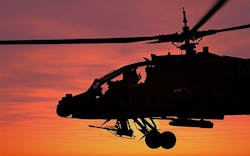Military rotorcraft modernization resumes despite budget cuts
Information provided by Jim Garamone of DoD News, Defense Media Activity (Follow Jim Garamone on Twitter: @GaramoneDoDNews)
WASHINGTON, 29 March 2016. The modernization of military rotorcraft shows signs of getting back on track, after being derailed by severe budget cuts, according to U.S. Department of Defense (DOD) officials.
A high level of operations combined with fiscal challenges contributed to a substantial reduction in Army aviation funding, Army Lt. Gen. Michael E. Williamson, deputy to the assistant secretary of the Army for acquisition, logistics, and technology, told the House Armed Services Committee’s subcommittee on tactical air and land forces.
Funding for Army aviation programs not only dropped $2 billion from fiscal year 2016 to fiscal year 2017, but also lost $531 million as a result of the fiscal 2015 Bipartisan Budget Act. “The immediate result is the procurement of fewer Black Hawks, Apaches and Chinooks,” Williamson affirms. Army officials studied the situation and proposed the Aviation Restructuring Initiative. As a result, the service was able to push savings into the field and fly its most modernized aircraft “while developing and fielding the right technologies to improve mobility, lethality, survivability, and mission command,” Williamson says.
The Army continues to study the report of the National Commission on the Future of the Army for its impact on modernization and procurement, Williamson adds. Officials are moving forward to address known capability gaps in Army aviation, but at a much slower pace, he cautions.
The fiscal year 2017 budget request includes several critical efforts for next-generation, rotary-wing capabilities, Williamson says, which include the advanced threat reduction system, degraded visual environment mitigation, and joint multirole technology demonstrator.
“In the field of modernization, we are focused on improved the Apache, Chinook, and Black Hawk helicopter fleets, as well as saving money for the American taxpayer, by pursuing a multiyear contract in fiscal 2017 for the Apache,” Williamson explains. “We will award the ninth multiyear contract for [the] Black Hawk and the second for [the] Chinook in fiscal 2017.”
The Army also is investing in: an improved turbine engine for the Apache and Black Hawk helicopters, which also meet worldwide demand for operations in high-altitude areas and in hot conditions, and refurbishing and modernizing its remotely piloted vehicle fleet, Williamson says.
You might also like:
Subscribe today to receive all the latest aerospace technology and engineering news, delivered directly to your e-mail inbox twice a week (Tuesdays and Thursdays). Sign upfor your free subscription to the Intelligent Inbox e-newsletter at http://www.intelligent-aerospace.com/subscribe.html.
Connect with Intelligent Aerospace on social media: Twitter (@IntelligentAero), LinkedIn,Google+, and Instagram.
Intelligent Aerospace
Global Aerospace Technology NetworkIntelligent Aerospace, the global aerospace technology network, reports on the latest tools, technologies, and trends of vital importance to aerospace professionals involved in air traffic control, airport operations, satellites and space, and commercial and military avionics on fixed-wing, rotor-wing, and unmanned aircraft throughout the world.


